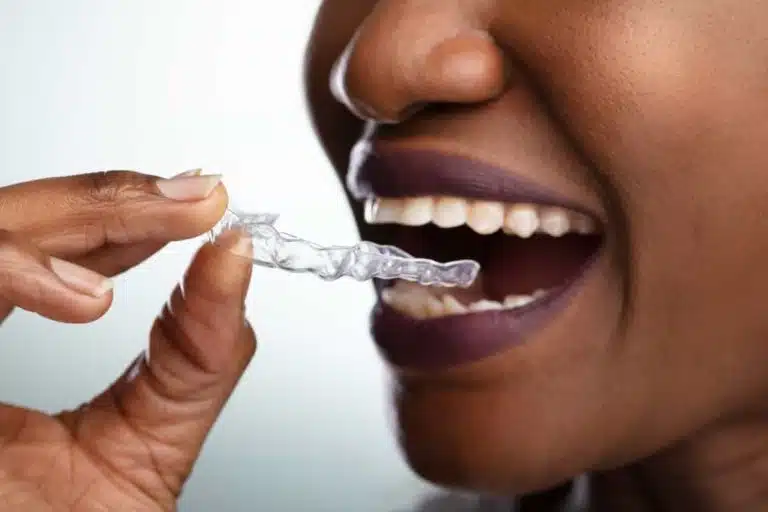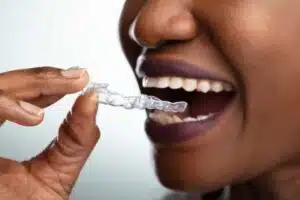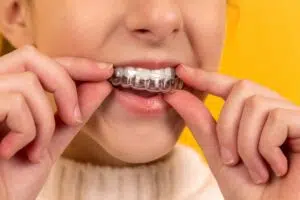
If you’re dealing with an overbite or have questions about this common dental issue, it’s essential to know that braces aren’t the only orthodontic treatment available today. Many people are also wondering if an Invisalign overbite treatment is possible. The simple answer is yes—but there’s a lot more you need to know.
Why Correcting Overbites Matter
An overbite is a dental condition where the upper front teeth overlap significantly with the lower front teeth when the jaws are closed. While a slight overbite is normal and doesn’t cause any problems, more pronounced overbites can lead to various issues.
Overbites matter for several reasons:
Aesthetic Concerns: An obvious overbite can affect the appearance of your smile, making some people self-conscious about their teeth.
Oral Health: In severe cases, overbites can lead to oral health problems, including difficulty chewing, excessive wear on teeth, and jaw pain.
Speech Difficulties: Overbites can also contribute to speech problems in some individuals.
Misalignment: Over time, untreated overbites can lead to misalignment of teeth and jaws, potentially requiring more extensive orthodontic treatment.
Causes of Overbites
Understanding why overbites develop can help shed light on how they can be corrected. Here are some common causes of overbites:
Genetics: Genetics play a significant role in the development of overbites. If your parents or grandparents had overbites, you may be more predisposed to this condition.
Thumb-Sucking: Prolonged thumb-sucking or pacifier use as a child can push the teeth forward, contributing to an overbite.
Tongue Thrusting: Some individuals develop overbites due to a habit of pushing their tongue against their front teeth when swallowing.
Jaw Irregularities: Irregularities in the size or position of the upper or lower jaw can also lead to overbites.
Missing Teeth: Missing or lost teeth can disrupt the natural alignment of your teeth, potentially causing an overbite.
What Is Invisalign?
Invisalign is a modern orthodontic treatment that uses a series of clear, removable aligners to straighten teeth and correct various dental issues, including overbites. These aligners are custom-made to fit your teeth and are virtually invisible when worn, making them a discreet alternative to traditional braces.
Benefits of Invisalign
Invisalign offers several advantages that make it a preferred choice for many individuals seeking orthodontic treatment, especially for overbites:
Discreet Appearance: Invisalign aligners are transparent, making them much less noticeable than traditional metal braces. This discretion is particularly appealing to adults and teenagers, who may feel self-conscious about wearing braces.
Removability: Invisalign aligners are removable, allowing you to take them out when eating, drinking, brushing, and flossing. This makes maintaining oral hygiene easier compared to braces, where food particles can get trapped.
Comfort: Invisalign aligners are made of smooth plastic, reducing the likelihood of irritation and discomfort often associated with braces and wires.
Shorter Treatment Duration: In some cases, Invisalign treatment can be quicker than traditional braces, although the exact duration depends on the severity of your overbite and other factors.
Precise and Predictable: Invisalign uses advanced technology to plan your treatment, providing a clear roadmap for the entire process. You can even preview the expected results before starting.
Invisalign Overbite Treatment
Invisalign is a suitable treatment option for many overbite cases, including mild to moderate overbites. It can address both overjet (horizontal overlap) and overbite (vertical overlap) issues. However, severe overbites may require more complex orthodontic solutions.
How Invisalign Corrects Overbites
Invisalign overbite correction works by applying gentle, controlled force to your teeth to gradually move them into their desired positions. Here’s how it corrects overbites:
Customized Aligners: Your orthodontist will create a series of custom aligners designed to shift your teeth incrementally. Each aligner will be worn for about one to two weeks, and you’ll progress to the next one in the series.
Gradual Adjustments: As you switch to each new aligner, your teeth will move slightly closer to their correct positions. This gradual process continues until your overbite is corrected.
Monitoring Progress: Throughout your Invisalign overbite treatment, you’ll have regular check-ups with your orthodontist to ensure that your overbite is progressing as planned. Adjustments can be made if necessary.
Invisalign provides a less intrusive and more comfortable way to address overbites, making it an attractive choice for those looking to improve their smile and oral health without the visibility and inconvenience of traditional braces.
The Invisalign Treatment Process
Understanding the steps involved in the Invisalign overbite treatment process is essential to feeling confident about your decision to correct your overbite with this innovative orthodontic solution.
1. Initial Consultation
The journey to Invisalign overbite correction begins with an initial consultation with a qualified orthodontist. During this meeting, you’ll discuss your concerns, goals, and expectations for treatment. The orthodontist will also perform a thorough examination of your teeth and take X-rays or digital scans to assess the severity of your overbite.
2. Digital Impressions and Treatment Planning
Invisalign overbite treatment relies on precise digital impressions of your teeth. Instead of the uncomfortable molds used in traditional braces, digital scans are taken to create a 3D model of your teeth. This digital model serves as the foundation for your treatment plan.
Your orthodontist will work with advanced software to map out the precise movements your teeth need to undergo to correct the overbite. This detailed planning ensures the effectiveness and predictability of the treatment.
3. Custom-Made Aligners
Once your treatment plan is finalized, a series of custom-made Invisalign aligners will be created for you. These aligners are designed to fit snugly over your teeth and are made of smooth, comfortable, BPA-free plastic.
4. Gradual Alignment
You’ll receive a set of aligners, typically wearing each set for one to two weeks before progressing to the next. Each aligner is slightly adjusted to continue moving your teeth into the desired positions.
5. Regular Check-Ups
Throughout your Invisalign overbite treatment journey, you’ll have regular check-ups with your orthodontist. These appointments are crucial for monitoring your progress and ensuring that your treatment plan stays on track. Your orthodontist can make adjustments or provide guidance as needed.
6. Maintenance and Aftercare
Once your Invisalign overbite treatment is done, you may need to wear a retainer to maintain the results. Retainers help prevent your teeth from shifting back to their original positions. Your orthodontist will provide specific instructions on how to care for your new smile.
Ready for a Confident Smile?
Discover the power of Invisalign for overbite correction at Palo Alto Orthodontics.
About Us
We’re Palo Alto Orthodontics, where advanced technology meets personalized care. Dr. Jenny Yoo and her team are here to help you achieve your best smile in a welcoming and relaxed environment.





